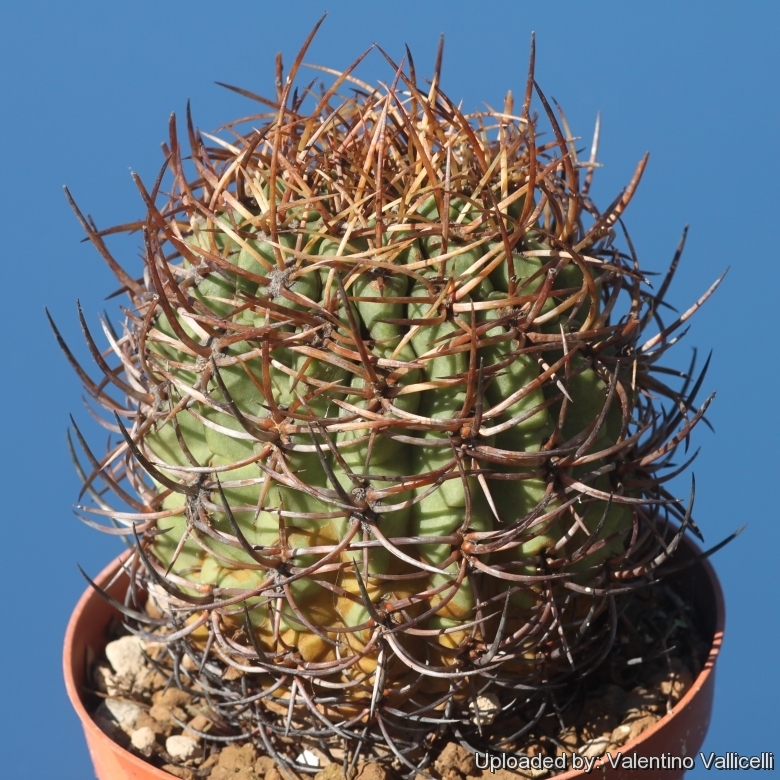
Eriosyce aurata Photo by: Valentino Vallicelli
Origin and Habitat: This species is endemic to Chile, where it is found in the regions of Atacama, Valparaíso and Metropolitana. Eriosyce aurataSN|2326]]SN|2326]] has a very wide range and occurs in many locations and within several protected areas such as National Park Fray Jorge and National Reserve Las Chinchillas. It is locally abundant and frequent.
Altitude range: 100 to 3,000 metres above sea level.
Habitat and Ecology: Eriosyce aurataSN|2326]]SN|2326]] is found in desert scrub and sclerophyllous scrub, on rocky north-facing slopes in the andean pre-cordillera. The major threat is illegal collection, the species has very high extraction rates. It suffers from vandalism.
Synonyms:
See all synonyms of Eriosyce aurata
back
Accepted name in llifle Database:Eriosyce aurata (Pfeiff.) Backeb.Cact. Journ. Brit. v. 9, fig. sub nomine Morawetzia Doelziana (1936); et inBlatter Kakteenforsch. 1937, No. 1, p. [8].Synonymy: 34
back
Common Names include:
SPANISH (Español): Sandillon, Asiento de la Suegra
Description: Eriosyce aurataSN|2326]]SN|2326]] is a very large and very spiny barrel cactus with numerous ribs.This fascinating plant is known by Chileans under the name of "sandillon" and resembles in habit and fruit to some of the giant species of Echinocactus in Mexico.
Stem: Spherical with abundant white wool on top up to 50 cm in diameter. Adult specimens become columnar, reaching over 90 cm in height.
Ribs: Around 30-35 ribs.
Spines: Spines colour is variable yellow, amber yellow, fox red or almost black. Juvenile specimens have 1 central spine and 8 radial, but the number increase as they get older and areoles can have over 20 spines on mature specimens.
Flowers: Red campanulate or funnel-shaped 5 cm long, from the apex of plant, with a white hairy floral tube. There might be over 50 flowers on a mature specimen (only mature specimens bloom). Ovary densely matted with matted wool.
Fruits: Oblong, becoming dry, dehiscing by a basal pore, very spiny above.
Seeds: Rather large, dull, black-pitted with a sub-basal hilum.
Subspecies, varieties, forms and cultivars of plants belonging to the Eriosyce aurata group
 Eriosyce algarrobensis F.Ritter: has stems less than 15 cm thick, larger areoles, 12-18 radial grey-brown spines and different seeds. Distribution: South Algarrobo, Depart. Huasco, Atacama, Chile.
Eriosyce algarrobensis F.Ritter: has stems less than 15 cm thick, larger areoles, 12-18 radial grey-brown spines and different seeds. Distribution: South Algarrobo, Depart. Huasco, Atacama, Chile. Eriosyce aurata (Pfeiff.) Backeb.: It is a very large and very spiny barrel cactus that resembles in habit and fruit to some of the giant species of Echinocactus in Mexico. The colourful spines are strong, glassy and usually amber coloured but also bright yellow or pure black.
Eriosyce aurata (Pfeiff.) Backeb.: It is a very large and very spiny barrel cactus that resembles in habit and fruit to some of the giant species of Echinocactus in Mexico. The colourful spines are strong, glassy and usually amber coloured but also bright yellow or pure black. Eriosyce ceratistes (Otto) Britton & Rose: A form with strong black spines.
Eriosyce ceratistes (Otto) Britton & Rose: A form with strong black spines. Eriosyce sandillon Phil.: The colourful spines are strong, glassy and usually amber coloured but also bright yellow or pure black.
Eriosyce sandillon Phil.: The colourful spines are strong, glassy and usually amber coloured but also bright yellow or pure black. Eriosyce sp. nova JS252 Illapel, 04 Coquimbo, Chile: Form with very strong spines.
Eriosyce sp. nova JS252 Illapel, 04 Coquimbo, Chile: Form with very strong spines.
Bibliography: Major references and further lectures
1) James Cullen, Sabina G. Knees, H. Suzanne Cubey “The European Garden Flora Flowering Plants: A Manual for the Identification of Plants Cultivated in Europe, Both Out-of-Doors and Under Glass” Cambridge University Press, 11/Aug./2011
2) David Hunt, Nigel Taylor “The New Cactus Lexicon” DH Books, 2006
3) Edward F. Anderson “The Cactus Family” Timber Press, 2001
4) Guerrero, P., Faundez, L., Saldivia, P. & Walter, H.E. 2013. Eriosyce aurata. The IUCN Red List of Threatened Species 2013: e.T151903A574579. http://dx.doi.org/10.2305/IUCN.UK.2013-1.RLTS.T151903A574579.en. Downloaded on 24 May 2016.
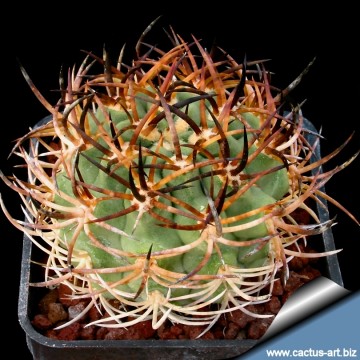 - The colourful spines are strong, glassy and usually amber coloured but also bright yellow or pure black. Photo by: Cactus Art
- The colourful spines are strong, glassy and usually amber coloured but also bright yellow or pure black. Photo by: Cactus Art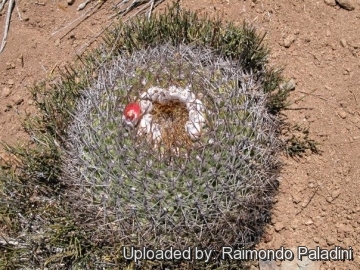 Habit at Fray Jorge - Chile. Photo by: Raimondo Paladini
Habit at Fray Jorge - Chile. Photo by: Raimondo Paladini Eulycnia Acida and Eryosice Aurata - Fray Jorge - Chile Photo by: Raimondo Paladini
Eulycnia Acida and Eryosice Aurata - Fray Jorge - Chile Photo by: Raimondo Paladini Eriosyce aurata Photo by: Cactus Art
Eriosyce aurata Photo by: Cactus Art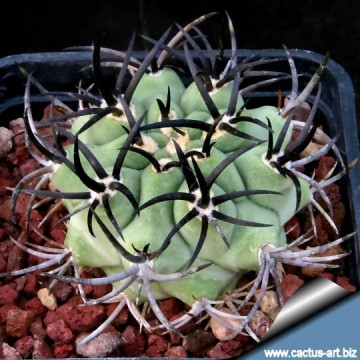 Eriosyce aurata (ceratistes) Huatalame 1000 m. A form with strong black spines Photo by: Cactus Art
Eriosyce aurata (ceratistes) Huatalame 1000 m. A form with strong black spines Photo by: Cactus Art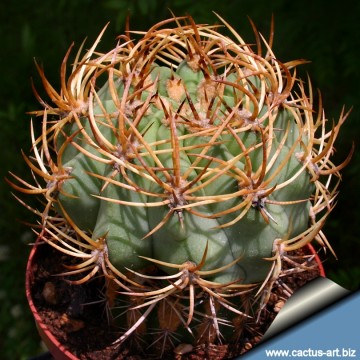 Grafted on trichocereus (this species is frequntly grafted to avoid root rot) Photo by: Cactus Art
Grafted on trichocereus (this species is frequntly grafted to avoid root rot) Photo by: Cactus Art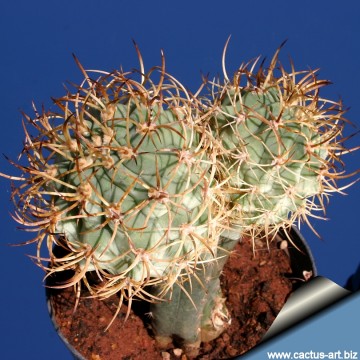 Eriosyce aurata Photo by: Cactus Art
Eriosyce aurata Photo by: Cactus Art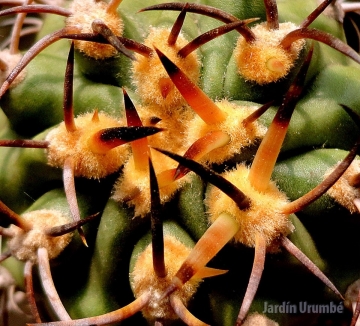 Eriosyce aurata Photo by: Alexander Arzberger
Eriosyce aurata Photo by: Alexander ArzbergerCultivation and Propagation: It is a very slow growing and extremely rot prone species if kept in a non ventilated place.
Soils: Require a very fast mineral draining drying soil (70-80% grit and 20-30% of land soil).
Watering Needs: Extremely root prone, needs good drainage, waterings should be rather infrequent in summer (do not overwater), to keep the plant compact and not become excessively elongated and unnatural in appearance. Keep dry in winter, or when night temperatures remain below 10° C.
Exposure: Requires strong sun exposure to develop good spinal growth (maximum brightness, sunlight accepted), but tolerate light shade.
Hardiness: Good heat tolerance. Hardy to at least -5°C for a short period but cannot tolerate long standing freezing temperature, and for an healthy cultivation ensure a minimum temperature of 5° C. Assure a good ventilation. USDA Hardiness Zone 9b and 11.
Propagation: Usually propagated from Seeds. (seldom produces offsets). The seedling growth is rapid. But the seedling are often grafted because the plants on their own roots (especially the bigger ones) are extremely prone to root rot. In fact the best and older specimens are the grafted ones.
Your Photos
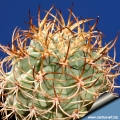
by Cactus Art



















